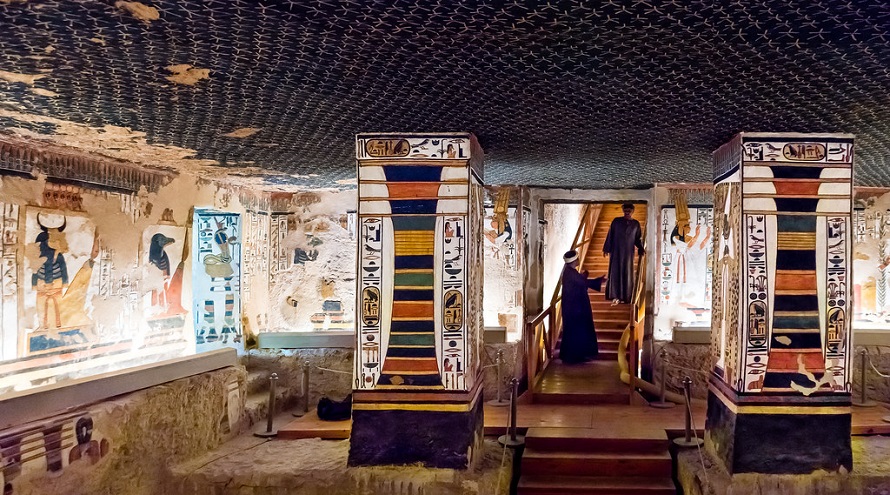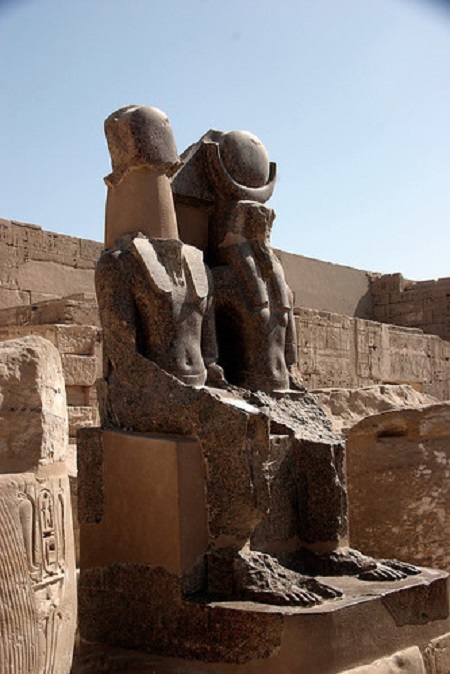 If you’ve never been to Egypt, your bucket list really should include a cruise on the Nile, seeing the Pyramids of Giza, and the other archaeological treasures located in Luxor. However, Egypt offers many more memorable exciting experiences including beautiful beaches, pristine coral reefs, and top-rated resort towns. So, to help you flesh out your list, here are the 25 best things to do in Egypt.
If you’ve never been to Egypt, your bucket list really should include a cruise on the Nile, seeing the Pyramids of Giza, and the other archaeological treasures located in Luxor. However, Egypt offers many more memorable exciting experiences including beautiful beaches, pristine coral reefs, and top-rated resort towns. So, to help you flesh out your list, here are the 25 best things to do in Egypt.
25 Best Things To Do In Egypt
1. Visit The Pyramids Of Giza

The Pyramids of Giza are one of the world’s most iconic sights. The Great Pyramid of Giza, a.k.a. the Pyramid of Khufu or the Pyramid of Cheops, harkens back nearly 5000 years. It is the oldest and largest of the three pyramids situated on the Giza plateau near Cairo, Egypt.
Once used as an actual tomb for the Pharaoh Khufu and his numerous queens. It was also surrounded by mastabas for relatives. The Great Pyramid is also the sole remaining structure of all the Seven Wonders of the Ancient World.
2. Take A Cruise On The Nile River

Cruise lazily down the famous Nile River, past the ancient temples and tombs. The majority of these cruises sail between Luxor and Aswan, with brief stops at Kom Ombo, Edfu, and Esna, on the way. You can choose to travel the river via cruise ship, on a smaller wooden ship called a dahabiya, or a little Egyptian sailboat known as a felucca. The cruise ships are most popular but the dahabiya are more romantic. (The latter is also a good choice for small groups.)
3. Learn Some History In The Grand Egyptian Museum

At press time, the Grand Egyptian Museum is reported to be under construction although “limited tours” are available. It is not going to be officially open until later this year. It will replace the Egyptian Museum. The museum will be the new home of the planet’s biggest collection of Egyptian artifacts including the famous Tutankhamun collection.
The museum is situated in Tahrir Square in Cairo. Be sure to see the Royal Mummies room and the gold mask and the golden sarcophagus of Tutankhamun. Allow yourself at least two hours to see everything.
4. Explore Cairo

The historic capital city of Egypt is located on the Nile River, where the arid desert transitions into the delta. Here you will see one of the Islamic world’s largest groupings of historic architecture ranging from 639 to some time in the early 1500s. Be sure to check out Al-Rifa’i Mosque, Salah El-Din Citadel, and Al-Azhar Mosque. Walk down popular Al-Muizz li-Din Allah al-Fatima Street, and shop for souvenirs in Khan el-Khalili. Old Cairo highlights include the Church of St. Sergius and Bacchus, Ben Ezra Synagogue, the Mosque of Amr Ibn al-As, and the Hanging Church.
5. See The Step Pyramid Of Djoser

You will find this pyramid, and others, in the Saqqara necropolis just outside the ancient city of Memphis. Experts note that it is the world’s “oldest stone building complex.” Following 14 years of restorations, it opened to the general public on March 5, 2020.
In fact, French architect Jean-Philippe Lauer was reportedly the main modern excavator in charge of reconstructing important parts of the complex. Today travelers can go down noticeably narrow stairways and wander through an olden labyrinth of various passageways that may be found ‘neath the Step Pyramid.
6. Venture Into The Pyramids In Dahshur

Not far from Cairo, sit a pair of Egypt’s oldest pyramids. They’re the Red Pyramid and the Bent Pyramid. The ancient Egyptians actually perfected their pyramid-constructing skills here. In fact, it was here that they built the Red Pyramid which was the world’s very first smooth-sided pyramid.
Touring these pyramids can be adventurous. Indeed, just to get inside, you’ll need to navigate steep, tight tunnels. Once below, you walk through the pyramid’s ancient chambers. Veteran visitors say that in a way, touring these pyramids is more exciting than touring the Pyramids of Giza.
7. Visit The City Of Alexandria

Nestled on the gleaming Mediterranean Sea, Egypt’s second-largest city, Alexandria, is also a well-known tourist destination. While you can take a day trip from Cairo to see this place, some travel writers suggest spending at least a night there. Some of the highlights here in the city of Alexandria include the Alexandria National Museum, Bibliotheca Alexandrina, the Catacombs of Kom El Shoqafa, the Citadel of Qaitbay, the Corniche, the Montazah Palace Gardens, the Serapeum, and the Stanley Bridge.
8. Kick It In Sharm El-Sheikh

For those travelers not yet in the know, Sharm El-Sheikh is arguably one of the most renowned beach resort towns in all of Egypt. If you need a break from touring temples and tombs, this is a great place to relax. Those in the know suggest trying a bit of scuba diving, chilling at Shark’s Bay, strolling through rad Ras Mohammed National Park, visiting Naama Bay, and picking up some super souvenirs at the Sharm Old Market.
9. Explore Dahab And Taba

These small resort towns nestled near the shining shore of the gorgeous Gulf of Aqaba, on the famous Sinai Peninsula, are truly list-worthy. Once a genuine Bedouin fishing village, Dahab is now world-famous for windsurfing and one of the peninsula’s best scuba diving destinations as well. In fact, if you’re an experienced scuba diver, you might want to consider diving in the infamous Blue Hole which is known to many as “The World’s Most Dangerous Diving Site.”
Taba is on the Red Sea Riviera. Specifically, it is across the official border from the city of Eilat in Israel. Naturally, it is quite a busy place in terms of crossing the border. Recommended activities here include swimming in Fjord Bay, exploring Salah El-Din Castle, scuba diving, and taking a fun day trip to the attractive Colored Canyon.
10. Hike To The Top Of Mount Sinai

Mount Sinai is a world-famous sacred pilgrimage site for Christians, Jews, and Muslims in Egypt. This is where the Old Testament notes that Moses was given the Ten Commandments. Anyone who hikes here starts their trek at the UNESCO World Heritage Site known as Saint Catherine’s Monastery. Before dawn, they choose between the challenging Steps of Penitence trail or the wider, easier Camel Path. Either way, the hike to the summit is more than six kilometers in total and you can enjoy seeing the sunrise from the summit.
11. Go Scuba Diving In The Red Sea

As previously noted, Egypt is actually a surprisingly exceptional place to go scuba diving if you know where to go and are the least bit adventurous. Believe it or not, the Red Sea has long been one of the top scuba diving locations on the planet. The water here is usually welcomingly warm and the visibility is excellent. Here you will discover pristine reefs and a number of different shipwrecks to explore as well. Undoubtedly, the Red Sea should be on your scuba diving bucket list too.
12. See Marsa Alam and Hurghada

The resort town of Marsa Alam on the Red Sea is growing in popularity. Some people come here just to see sea turtles on Abu Dabab Beach. It’s also a hot spot for scuba diving, snorkeling, and kitesurfing.
Also on the Red Sea, just north of Marsa Alam, is Hurghada. Europeans already know this is a popular winter destination. The beaches here are lined with upscale resorts. Recommended activities here include kitesurfing, windsurfing, scuba diving, snorkeling, and swimming with the dolphins. You can also visit the Giftun Islands or Luxor.
13. Visit The Valley Of The Kings

The Valley of the Kings is one of the world’s most famous archaeological sites. It is also a royal burial ground in Egypt with more than 60 tombs of Egyptian rulers from 1539 to 1075 BC. All the tombs here are exquisitely decorated.
Only a handful are open to the public. Your main entrance ticket includes eight tombs, three of which you can visit. If you’d care to visit the tombs of Tutankhamun, Seti I, and Ramesses V and VI, you will have to pay an extra fee.
14. Venture Into The Tomb Of Nefertari

Travel to the famous Valley of the Queens; the official burial site of all the pharaohs’ wives. The tombs here are less grand and smaller in size than those in the previously mentioned Valley of the Kings. There is, however, one noteworthy exception, the tomb of the famous Queen Nefertari. The incredible tomb of Queen Nefertari is actually one of Egypt’s most spectacular. The colors are a lot more vibrant and the degree of detail is more memorable than what you may see anywhere else in Egypt.
15. See The Mortuary Temple of Queen Hatshepsut

Queen Hatshepsut ruled Egypt for more than two decades and was one of the world’s most powerful female rulers. You will find her mortuary temple on Deir el-Bahri’s impressive cliffs. It’s arguably one of the most beautiful temples and architectural achievements in Egypt.
Its colonnaded structure actually tells a story. The Birth Colonnade tells the tale of Hatshepsut’s divine creation. The Punt Colonnade speaks to her travels to Punt and the valuable goods with which she returned. Visit the impressive Temple of Anubis and the Temple of Hathor too.
16. Check Out The Mortuary Temple Of Ramesses III

This impressive mortuary temple is located at Medinet Habu on the West Bank of Luxor. It is a large temple complex that is dedicated to Ramesses III. The temple features several courtyards, peristyle hals, and pylons highlighted with well-known reliefs of the Sea People’s defeat during Ramesses III’s reign. This temple has an orthodox design and resembles the neighboring mortuary temple of Ramesses II a.k.a. The Ramesseum.
17. Be Amazed By The Karnak Temple Complex

Karnak Temple is a popular tourist destination and attracts many visitors every year. It is second only to the Pyramids of Giza in terms of popularity. It is second only to Cambodia’s Angkor Wat, this huge Karnak Temple is the world’s largest temple complex.
For more than two centuries, nearly 30 pharaohs have erected additional buildings, monuments, and temples added to it. Visitors can stroll the walkway lined with striking ram-headed sphinxes, visit Hypostyle Hall, study the reliefs on the pylons, and check out the obelisks of Hatshepsut and Tuthmosis I.
18. Explore Luxor Temple

The Luxor Temple is quite similar in appearance to Karnak Temple. Veteran visitors say it has the overall feel of a smaller version but the fact is that this building actually served a much different purpose than a lot of the others in the area of Luxor. It was not dedicated to one specific pharaoh or god. Built in 1400 BC, by Ramesses II and Amenhotep III, it was probably the place where numerous ancient Egyptian kings were officially crowned.
19. Journey To Abydos And Dendera

A day trip from Luxor can take you to the shores of the Nile where you will find two of Egypt’s most well-preserved temple complexes. Abydos is a sacred city that is home to the striking temple of Seti I. Dendera is where you will see The Hathor Temple which some say is one of Egypt’s “most colorful temples.” Indeed, it features incredible hypostyle halls and an exceptionally detailed ceiling. Seeing them both in one day involves hours of driving but there aren’t many tourists even at the peak of the season.
20. See The Temple Of Horus

The temple in Edfu is dedicated to the well-known god Horus and was constructed in the Ptolemaic period somewhere between 237 and 57 BC. Despite being more than 2000 years old, this temple is in excellent condition and the first pylon is almost perfect. You can visit this temple on a drive between Aswan and Luxor or even while you are on certain Nile cruises. Take a good look and you will get a good idea about just how these temples once looked and even how they were first built.
21. Visit The Temple Of Kom Ombo

The famous Temple of Kom Ombo, in the village of the same name, is a unique temple that was built for two different gods. One-half of the temple complex is dedicated to the falcon-headed god named Horus. The other half is dedicated to the crocodile-headed known as Sobek. Sobek was the god of fertility of the land by the Nile while Horus was the god of healing, kingship, protection, the sky, and the sun. Stop and see it as you drive from Aswan to Luxor, on a cruise, or even a day trip.
22. Travel To The Twin Temples

Abu Simbel is one of Egypt’s most stunning monuments found on the bank of lovely Lake Nasser. This pair of twin temples were constructed by Ramesses II more than 3,000 years ago and have survived the ravages of time. More importantly, following the construction of the massive Aswan High Dam, this entire ancient complex was taken apart, moved to higher ground, and reassembled.
You can reach the temples on a day trip from either Cairo or Aswan. Driving there is cheaper but takes more time. Flying takes less time but is costlier.
23. Take In The Sights At The Philae Temple

The famous Philae Temple is one of Egypt’s most well-preserved Ptolemaic temples. It was constructed during the Ptolemaic period, between 332 and 30 BC. At least two-thirds of the remaining structures in the complex were built at that time.
The temple was officially dedicated to Isis, but Hathor and Osiris were honored here as well. In 1902 following the erection of the Aswan Old Dam, all of Philae Island, including the temples, was submerged. The temples were painstakingly dismantled and reassembled on the neighboring island of Agilkia in the 1960s.
24. Brave The White Desert

The wondrous White Desert is an Egyptian national park nestled in the Western Desert in the Sahara. This almost alien landscape is dotted with a number of uniquely shaped, rugged limestone rock formations. In order to reach this place, you will have to rent a four-by-four because it is a rather lengthy drive from the center of Cairo. Most travelers interested in seeing the White Desert sign up for a guided tour which often includes a stop at the Black Desert and the Bahariya Oasis as well.
25. Venture To The Oases In The Western Desert

Get away from the temples, tombs, and busy cities here in the Western Desert. Here you will discover several worthwhile oases replete with freshwater springs and groves of palm trees. The Bahariya Oasis features some small ancient sites and is often a part of tours of the White Desert.
The Fayoum Oasis is south of Cairo, nestled next to the Nile River. The beautiful, remote Siwa Oasis is near the Libyan border and 560 kilometers from Cairo. Visit the waterfalls and man-made lakes at Wadi El Rayan and see all the ancient skeletons of whales, sharks, and other fossils at the fascinating (albeit stark) Valley of the Whales too.








